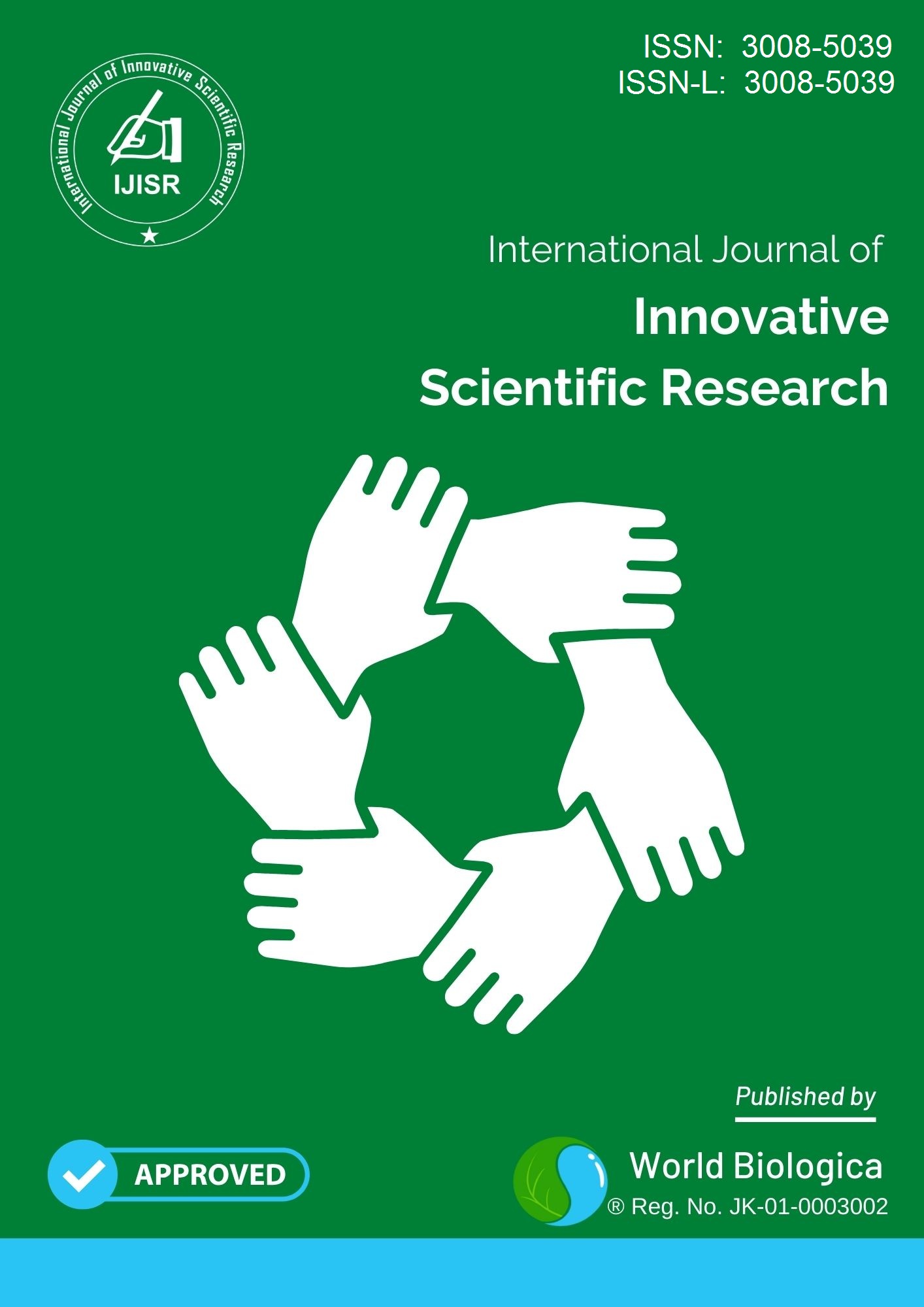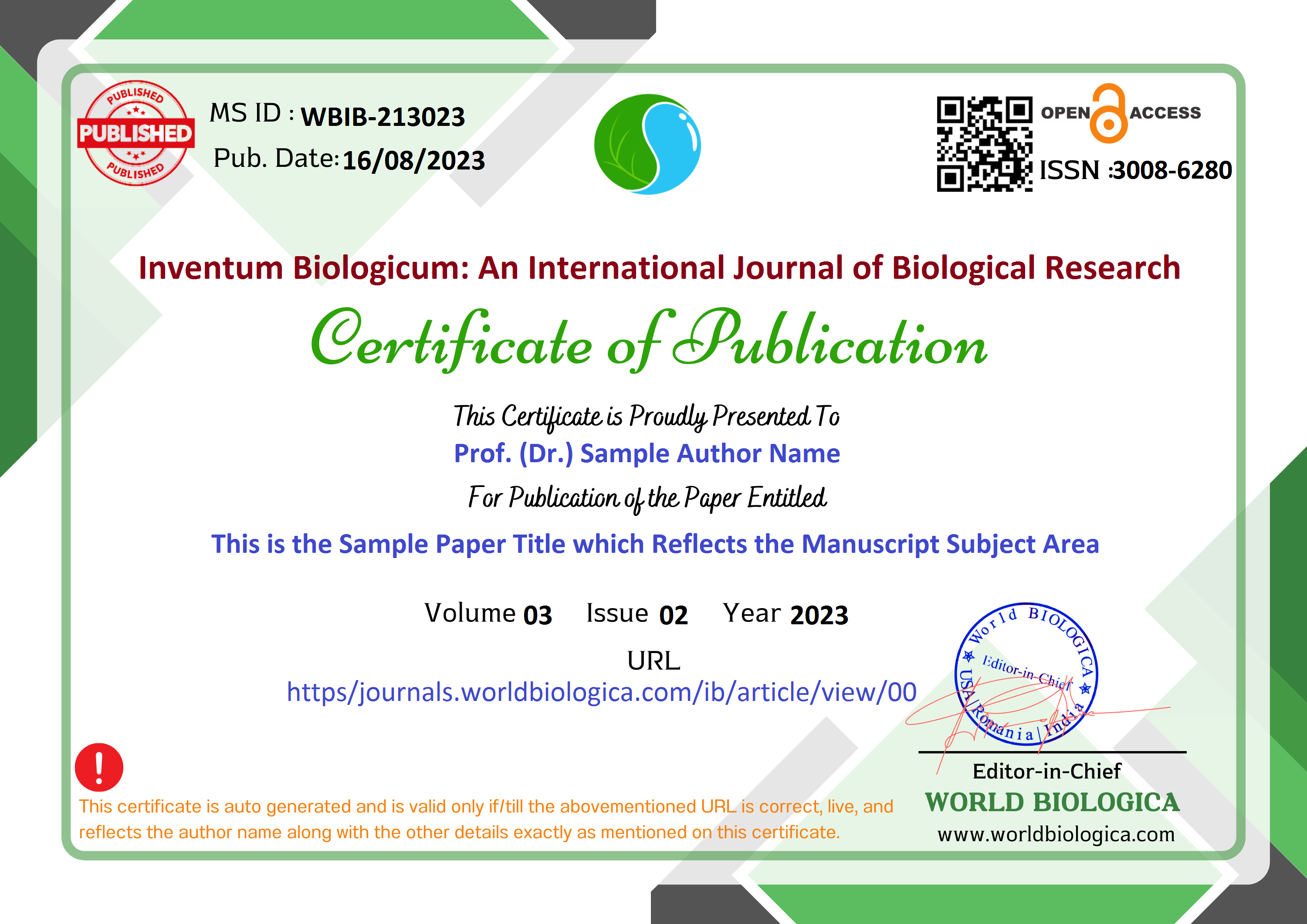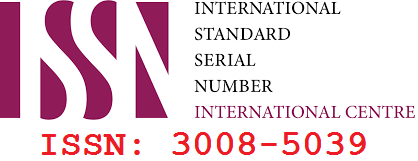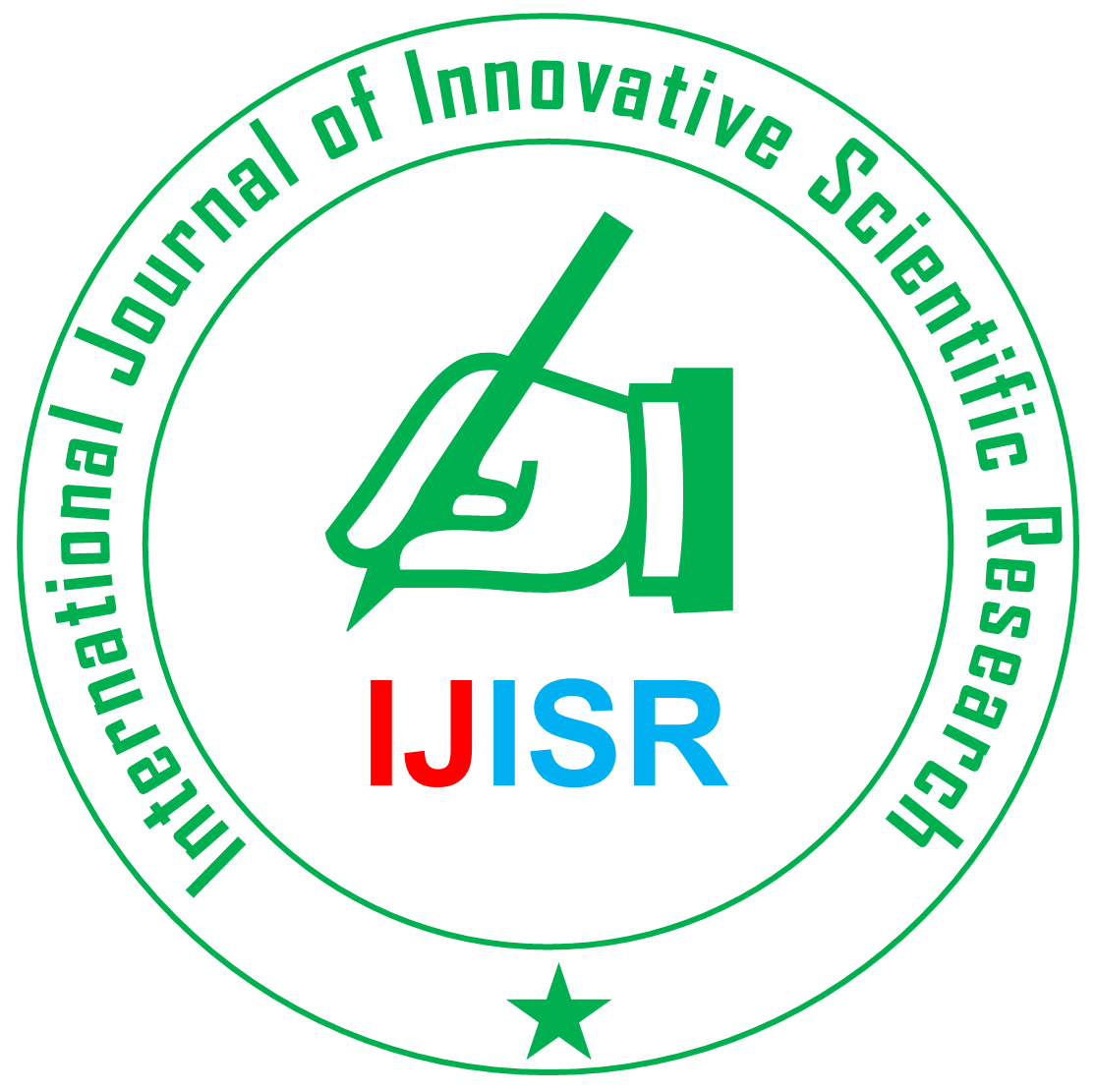
Information For Authors
International Journal of Innovative Scientific Research (IJISR) publishes the following manuscript types:
- Original Research Articles
- Review Articles
- Short Communications
- Case Study
- Mini Review
- Letter to Editor
MANUSCRIPT STRUCTURE
A. RESEARCH ARTICLE FORMAT
The preferred format of all manuscripts are in MS office (2003 or above). Manuscript should be concisely typewritten in 1.5 spaces in A4 sized sheets. The pages shall be numbered consequently. Only on one side, with a 2.5 cm margin on all sides. The manuscript shall be prepared in Times New Roman using a font size of 12 and title shall be of font size 14, bold space capitals. All section titles in the manuscript shall be in font size 12, bold face capitals and subtitles in each section shall be in font size 12, bold face lower case. Illustrations (Figures & Tables) must be inserted at appropriate place in the article. Standard International Units should be used throughout the text. There shall not be any decorative borders anywhere in the text including the title page. The manuscript should be starting with the title page and the text should be arranged in the following order:
- Title Page
- Abstract
- Keywords
- Introduction
- Materials and Methods
- Results and Discussion
- Conclusion
- Acknowledgements
- Funding Information
- Declaration of Conflict
- References
Title Page
The title should be as short as possible on the first page and provide precise information about the contents. The title should be followed by full names of author(s), affiliations of author (s) and institutional addresses.
Authors and Co-Authors Details and Affiliations
Each author must provide their full name including their forenames and surname. The Corresponding Author of the manuscript must be marked with an asterisk*. In addition the corresponding author must include Telephone and E-mail address. If any of the co-authors are from different organizations, their addresses too should be mentioned and indicated using numbers after their names. Maximum 10 authors should be allowed.
Abstract
Provide on a separate page an abstract of not more than150-250 words. A concise and factual abstract is required. The Abstract should be informative and completely self-explanatory, briefly present the topic, state the scope of the experiments, indicate significant data, and point out major findings and conclusions. An abstract is often presented separately from the article, so it must be able to stand alone. For this reason, standard nomenclature should be used and abbreviations and references should be avoided. Graphical abstract is not allowed.
Keywords
Provide three to six appropriate keywords after the abstract.
Materials and Methods
It should be complete enough to allow experiments to be reproduced. All the procedures should be described in detail, previously published procedures should be cited, and important modifications of published procedures should be mentioned briefly. Capitalize trade names and include the manufacturer's name and address. Subheadings should be used. Methods in general use need not be described in detail.
Results
Results and their significance should be presented clearly and concisely, preferably in the form of graphs and tables which should be self-explanatory.
Discussion
It should contain a critical review of the results in the light of relevant literature. Results and Discussion may be combined.
Conclusions
This should state clearly the main conclusions of the research and give a clear explanation of their importance and relevance. Summary illustrations may be included.
Acknowledgement
Acknowledgements should be placed in a separate section after the conclusion.
Funding Information
If external funding has been obtained for the study, then that should be mentioned under a separate header "Funding", after the acknowledgements. If no funding information is applicable, the authors shall use the below sentence;
“This research did not receive any specific grant from funding agencies in the public, commercial, or not-for-profit sectors.”
Declaration of Conflict
Authors shall declare the conflicts after the ‘Funding Information’. In case of no conflicts of interest, the authors shall use the below sentence;
“The authors declare that they have no known competing financial interests or personal relationships that could have appeared to influence the work reported in this paper.”
References
The authors are responsible for the accuracy of the bibliographic information. The list must be in alphabetical order (A→Z) and numbered. The list of references should be included on separate 1.5 spaced pages at the end of the text. The style and punctuation of the references should confirm the APA version or must be confined to the following examples:
- Journal references:
1st author last name, 1st author first name initial. 1st author middle name initial. 2nd author last name, 2nd author first name initial. 2nd author middle name initial., … (year). Article title: subtitle. Journal name, volume(issue), page range.
Gennaro, R., Zanetti, M., Benincasa, M., Podda, E., & Miani, M. (2002). Pro-rich antimicrobial peptides from animals: structure, biological functions and mechanism of action. Current pharmaceutical design, 8(9), 763-778.
Clerico, A., Zucchelli, G. C., Pilo, A., & Emdin, M. (2005). Clinical relevance of biological variation of B-type natriuretic peptide. Clinical chemistry, 51, 925-926.
- Book with one author:
Author, A. A. (2005). Title of work. Publisher.
- Book with two authors:
Author, A. A., & Author, B. B. (2005). Title of work. Publisher.
- Book with more than two authors:
Author, A. A., Author, B. B., & Author, C. C. (2005). Title of work. Publisher.
- A publication in press:
Junho, S. (in press). Roadmap for e-commerce standardization in Korea. International Journal of IT Standards and Standardization Research.
- A publication in a language other than English:
Amano, N., & Kondo, H. (2000). Nihongo no goi tokusei [Lexical characteristics of Japanese language]. Sansei-do.
- Edited book:
Zhao, F. (Ed.). (2006). Maximize business profits through e-partnerships. IRM Press.
- Chapter in an edited book:
Jaques, P. A., & Viccari, R. M. (2006). Considering students’ emotions in computer-mediated learning environments. In Z. Ma (Ed.), Web-based intelligent e-learning systems: Technologies and applications (pp. 122-138). Information Science Publishing.
- Published proceedings:
Deci, E. L., & Ryan, R. M. (1991). A motivational approach to self: Integration in personality. In Proceedings of Nebraska Symposium on Motivation (vol. 38, pp. 237-288). University of Nebraska Press.
- Unpublished doctoral dissertation or master’s thesis:
Wilfley, D. (1989). Interpersonal analyses of bulimia: Normal-weight and obese [Unpublished doctoral dissertation]. University of Missouri, Columbia, MO, United States.
- A presented paper:
Lanktree, C., & Briere, J. (1991, January). Early data on the trauma symptom checklist for children (TSC-C) [Paper presentation]. The meeting of the American Professional Society on the Abuse of Children, San Diego, CA, United States.
- Website:
VandenBos, G., Knapp, S., & Doe, J. (2001). Role of reference elements in the selection of resources by psychology undergraduates. http://jbr.org/articles.html; Accessed on 15 June 2019
In-Text Citations
When writing academically, it is very important to properly cite and reference the materials used in your writing. Proper citation allows your readers to further explore your particular subject matter. Citing also protects you against plagiarism by clearly indicating and differentiating which information comes from other sources and which is your own work and writing. In-text citations are used to show where you retrieved the information that you are using to make specific arguments in your writing. Below are some general rules to follow when using in-text citations.
Citing a work/article by single author: (Dalglish, 2009)
A work by two authors: (Dalglish & Rush, 2007)
A work by more than two authors: (Barnes et al., 2003)
Two or more works cited at the same time: (Berndt, 2002; Harlow, 2012)
Authors with the same last name: (G. Johnson, 2018; P. Johnson, 2014)
Two or more works by the same author in the same year: Allen, 2013b
Integrated/direct citations: The work of Jones (2018) has been used……; Jones and Collymore (2016) showed in their previous work that….; Park et al. (2003) discuss the….; Dalglish (2006), Jones (2018), Jones and Collymore (2002), and Park et al. (2011) discuss in their research……
Tables
These should be numbered with Arabic numerals. Each table should be typed using a table format (i.e., each variable must be typed into a separate cell in the table) with only horizontal lines above and below the table column headers and at the bottom of the table. No vertical lines should be included in any table. The title should be typed at the top of the table in the sentence case format, i.e., only the first name should be in capital letters; as appropriate. Any footnote should be typed at the bottom of the table in italic.
Illustrations and Figures
Figures must be numbered independently of tables, multimedia, and 3D models and cited as the relevant point in the manuscript text, e.g. "Fig. 1", "Fig. 2", etc. All figures including photographs should be numbered consecutively in Arabic numerals in the order of their appearance in the text and bear a brief title in lower case bold face letters below the figure. Do not duplicate data by presenting it both in the text and in a figure. For any figure directly extracted from previously published materials, you must have written permission from the publisher of that figure for reprint use. A copy of that permission release must be submitted with your article.
B. REVIEW ARTICLES
Review articles should not be more than 25 pages and contain comprehensive coverage of relevant literature. Review articles should preferably be written by scientists who have in-depth knowledge of the topic. All format requirements are similar to those applicable to Research papers. Review articles need not to be divided into sections such as Materials and methods, and Results and discussion, but should definitely have an abstract, introduction, Conclusion, Funding information, Declaration of conflict and References.
C. SHORT COMMUNICATIONS
The research and technical communications section of this journal (maximum 3,000 words) is open to interesting results worthy of publication without requiring extensive introduction and discussion. This section should be organized as follows: Abstract, Introduction, Materials and methods, Results and discussion (combined). Not more than 10 references should be provided. Tables, figures and references are to be arranged in the same way as for research papers. Brevity of presentation is essential for this section.
TERMINOLOGIES & NOMENCLATURE
Note: Figures and tables should be included at appropriate places in the manuscript.
Chemical Terminology: The chemical nomenclature used must be in accordance with that used in the Chemical Abstracts.
Biological Nomenclature: Names of plants, animals and bacteria should be in italics.
Enzyme Nomenclature: The trivial names recommended by the IUPAC-IUB Commission should be used. When the enzyme is the main subject of a paper, its code number and systematic name should be stated in its first citation in the paper.
Symbols and Abbreviations: Use only standard abbreviations. The use of non-standard abbreviations can be extremely confusing to readers. Avoid abbreviations in the title. The full term for which an abbreviation stands should precede its first use in the text unless it is a standard unit of measurement
ETHICAL MATTERS
Authors involving in the usage of experimental animals and human subjects in their research work should seek approval from the appropriate Institutional Animal Ethics Committee in accordance with "Principles of Laboratory Animal Care". The material and methods section of the manuscript should include a statement to prove that the investigation was approved and that informed consent was obtained.
PUBLICATION MALPRACTICE
International Journal of Innovative Scientific Research (IJISR) is committed to upholding the highest standards of publication ethics and takes all possible measures against any publication malpractices. All authors submitting their works to the journal for publication as original articles attest that the submitted works represent their authors’ contributions and have not been copied or plagiarized in whole or in part from other works. The authors acknowledge that they have disclosed all and any actual or potential conflicts of interest with their work or partial benefits associated with it. In the same manner, International Journal of Innovative Scientific Research (IJISR) is committed to objective and fair double-blind peer-review of the submitted publication works and to prevent any actual or potential conflict of interests between the editorial and review personnel and the reviewed material. Any departures from the above-defined rules should be reported directly to the Editors-in-Chief, who are unequivocally committed to providing swift resolutions to any of such a type of problems.
AUTHORSHIP
A manuscript will be considered for the publication based on the below understanding:
All named authors should agree to its submission
It is not currently being considered for the publication by another journal
If the paper is accepted, it will not be subsequently published in the same or similar form in any language without the consent of the publisher. Any changes to the author list after submission, viz., a change in the order of the authors, deletion or addition of the authors needs to be approved by a signed letter from each author.
COPYRIGHT
Submission of the manuscript represents that the manuscript has not been published previously and is not under consideration for publication elsewhere. Authors would be required to sign a Copy Right Transfer Agreement Form once the manuscript is accepted.
GALLEY PROOFS
Unless indicated otherwise, galley proofs are sent to the address given for correspondence. It is the responsibility of the corresponding author to ensure that the galley proofs are returned without delay.
PRIVACY STATEMENT
The names and email addresses entered in this journal site will be used exclusively for the stated purposes of this journal and will not be made available for any other purpose or to any other party.












